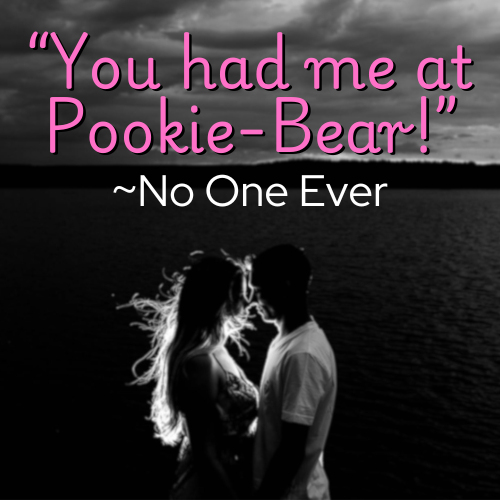She’s Not a Cat, So Why Call Her Kitty?

In the world of romance writing, the little things often have the biggest impact—like the way characters address each other. I’ve dabbled in endearments for my characters to the point almost all of my main characters get a pet name. While working on my latest attempt at something different (shifter romance in current times), I’ve been pondering laying off the practice.
Pet names and endearments can add layers of intimacy to the relationship between lovers. However, using them effectively requires balance and I am, most assuredly, not balanced. Just ask my mother. Moving on …
Too much honey-bunny or sweet-cheeks, and it can feel unrealistic or cheesy; too little, and you might miss the chance to make your characters’ dynamic pop off the page. For me, literally a few minutes ago, I sat and argued with myself about not forcing little mate or little wolf or little anything to come out of my MMC’s sexy but stupid mouth.
Don’t worry, I’m winning the argument … and losing. Hey, I’m a complicated gal!
The Pros of Pet NamesPet names can be more than just fluffy terms of affection; they’re a form of verbal intimacy, reinforcing the relationship between characters. For strong female leads, these names should reflect admiration, respect, or an emotional connection rather than mere condescension.
That is, unless you’re going for a little condescension so there’s more conflict. It’s a delicate dance, y’all, so mind the steps!
A well-chosen pet name can:
Reflect the personality or traits of the character.Show an evolving relationship (from formal to intimate).Highlight the quirks or private jokes between the couple.Add emotional depth to the dialogue during pivotal moments.Just make sure the endearments fit the narrative. I’ve had male characters use pet names that reflect some degree of insight. For example, in Shadow’s Lyric, the MMC, Draven, refers to the object of his desire as Angel. Her personality is far from angelic, but there’s a reason behind it, one I simply cannot reveal at this time.
Avoid the Cheese!I try to avoid the cringe. Below is how I think through it:
Make It Unique to the Couple: If it feels forced or generic, it can make a scene feel clichéd. Consider what the male character would realistically call the female based on their dynamic. Avoid common or overused terms unless they serve a specific purpose (e.g., a more typical name could be used ironically or at a pivotal moment to break tension).Stay True to the Tone: If you’re writing a dark, brooding romance, Pookie aint’ gonna sit well with the reader–not that Pookie ever sits well.Be Careful with Overuse: Don’t let it take over the dialogue. Too much reliance on endearments can make interactions feel unnatural. Use them sparingly—when a pet name slips into a heated argument or a tender moment, it holds more weight.The Grammar of EndearmentsFull disclosure: this one came straight from Ai. Sometimes I doubt my grammatical prowess. Other times I know it’s wrong. See what I’m getting at?
When to Capitalize: Pet names and endearments should be capitalized when they are used in place of a character’s actual name. For example: “What’s wrong, Love?” or “Come here, Beautiful.”When Not to Capitalize: If a pet name or endearment is used generically, it doesn’t need to be capitalized. For example: “You’re my love,” or “She’s such a darling.”Pay attention to context and the relationship dynamic to decide whether the endearment is functioning more like a proper noun or a descriptive word.
Some Common Pet Names and Endearments for Female CharactersLoveDarlingSweetheartBabyAngelBabeHoneyBeautifulGorgeousPrincessSome Common Pet Names and Endearments for Male CharactersHandsomeLoveDarlingBabeHoneyBabyTigerBig GuyStudCowboyUnique and Less Common Pet Names for Female CharactersTempestSirenPhoenixRavenLionessDoveHellionStarlightHuntressGypsyUnique and Less Common Pet Names for Male CharactersI hate most of these, but here’s what I’ve come across:
BearMisterDragonCaptainWolfShadowMaverickHot StuffBoss ManDreamboatConclusionWhen done well, pet names and endearments will feel like an organic part of your story, enhancing both the romantic tension and emotional stakes in a way readers will love. When done poorly? Ick.
No pressure. Ha!
Happy writing!
SourcesTaylor, Bronwen. Romance Writing: Dialogue to Build Intimacy. Writer’s Digest, 2019.Patterson, Jessica. Character Development: Personal Traits and Dialogue Techniques. Fiction Writers Collective, 2021.Carpenter, Lila. Crafting Romance: Writing Meaningful Relationships in Fiction. Romance Authors International, 2018.Martinez, Sophia. Avoiding Clichés in Romance: Dialogue Tips for Writers. Creative Writers Monthly, 2020.Knight, Emma. Tone and Voice: Writing Characters True to Their World. Dark Moon Press, 2017.Johnson, Emily. Writing Authentic Romance: Balancing Dialogue and Action. The Romance Workshop, 2022.Nguyen, Hana. The Emotional Impact of Words in Romantic Fiction. Love Notes Publishing, 2021.Brooks, Catherine. Pacing the Romance: When to Introduce Pet Names. Romance Writers Quarterly, Winter 2019.Sharma, Priya. Writing Emotionally Charged Scenes: Do’s and Don’ts. Romance Writers Magazine, Spring 2020.Miller, Alistair. Capitalization in Creative Writing: Names, Titles, and Endearments. Grammar Rules for Fiction Writers, 2018.Douglas, Amy. Proper Nouns vs. Descriptive Terms in Fiction. Editor’s Toolkit Series, Vol. 2, 2019.Lee, Jason. Enhancing Romantic Tension: Tools for Crafting Endearments. Love Stories Press, 2023.


